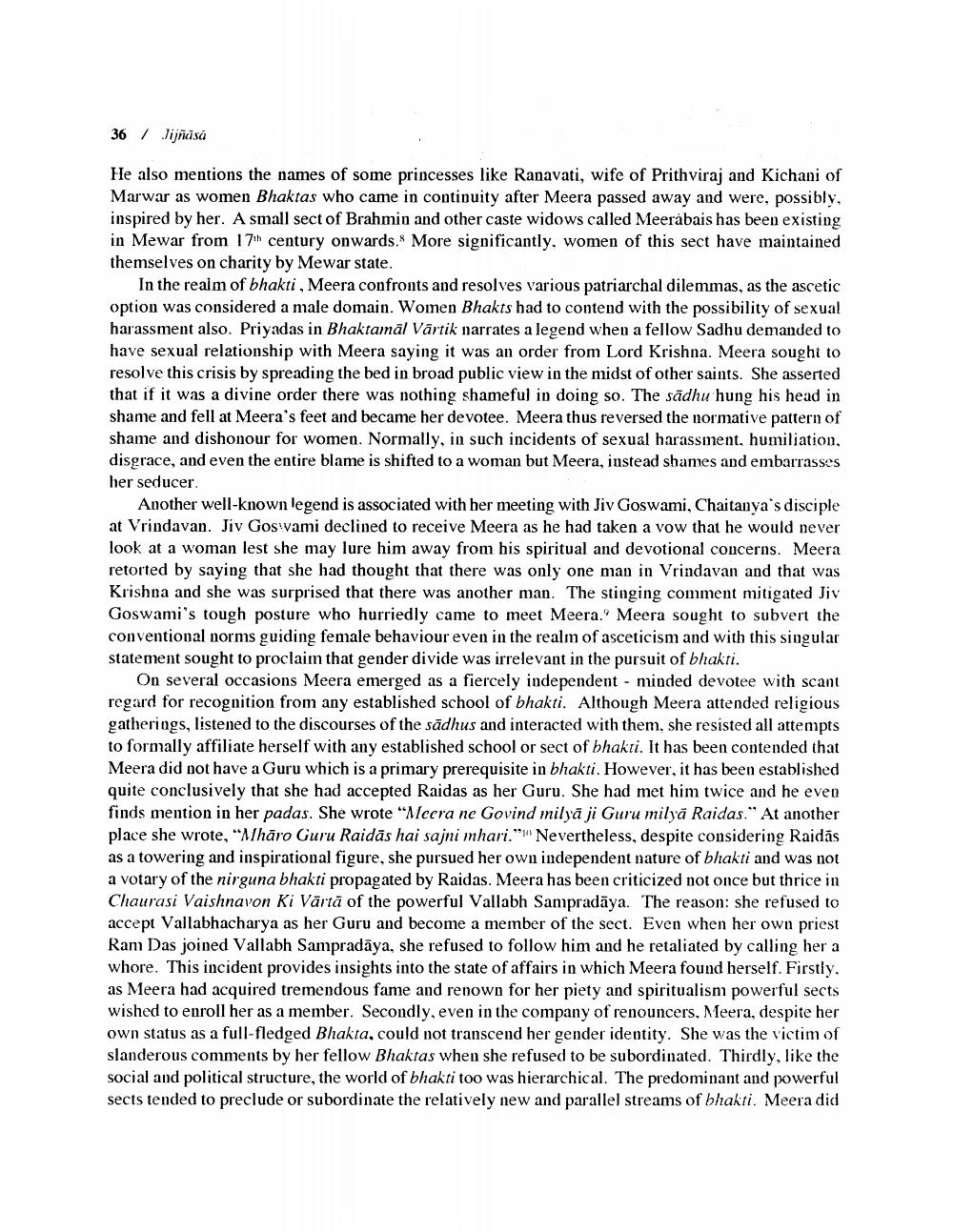________________
36
/
Jijrcsa
He also mentions the names of some princesses like Ranavati, wife of Prithviraj and Kichani of Marwar as women Bhaktas who came in continuity after Meera passed away and were, possibly, inspired by her. A small sect of Brahmin and other caste widows called Meerabais has been existing in Mewar from 17th century onwards. More significantly, women of this sect have maintained themselves on charity by Mewar state.
In the realm of bhakti, Meera confronts and resolves various patriarchal dilemmas, as the ascetic option was considered a male domain. Women Bhakts had to contend with the possibility of sexual harassment also. Priyadas in Bhaktamāl Vārtik narrates a legend when a fellow Sadhu demanded to have sexual relationship with Meera saying it was an order from Lord Krishna. Meera sought to resolve this crisis by spreading the bed in broad public view in the midst of other saints. She asserted that if it was a divine order there was nothing shameful in doing so. The sādhu hung his head in shame and fell at Meera's feet and became her devotee. Meera thus reversed the normative pattern of shame and dishonour for women. Normally, in such incidents of sexual harassment, humiliation, disgrace, and even the entire blame is shifted to a woman but Meera, instead shames and embarrasses her seducer
Another well-known legend is associated with her meeting with Jiv Goswami, Chaitanya's disciple at Vrindavan. Jiv Goswami declined to receive Meera as he had taken a vow that he would never look at a woman lest she may lure him away from his spiritual and devotional concerns. Meera retorted by saying that she had thought that there was only one man in Vrindavan and that was Krishua and she was surprised that there was another man. The stinging comment mitigated Jiv Goswami's tough posture who hurriedly came to meet Meera. Meera sought to subvert the conventional norms guiding female behaviour even in the realm of asceticism and with this singular statement sought to proclaim that gender divide was irrelevant in the pursuit of bhakti.
On several occasions Meera emerged as a fiercely independent - minded devotee with scant regard for recognition from any established school of bhakti. Although Meera attended religious gatherings, listened to the discourses of the sādhus and interacted with them, she resisted all attempts to formally affiliate herself with any established school or sect of bhakti. It has been contended that Meera did not have a Guru which is a primary prerequisite in bhakti. However, it has been established quite conclusively that she had accepted Raidas as her Guru. She had met him twice and he even finds mention in her padas. She wrote "Mecra ne Govind milyä ji Guru milyä Raidas." At another place she wrote, "Alhāro Guru Raidās hai sajni mhari."" Nevertheless, despite considering Raidās as a towering and inspirational figure, she pursued her own independent nature of bhakti and was not a votary of the nirguna bhakti propagated by Raidas. Meera has been criticized not once but thrice in Chaurasi Vaishnavon Ki Vārtā of the powerful Vallabh Sampradāya. The reason: she refused to accept Vallabhacharya as her Guru and become a member of the sect. Even when her own priest Ram Das joined Vallabh Sampradāya, she refused to follow him and he retaliated by calling her a whore. This incident provides insights into the state of affairs in which Meera found herself. Firstly, as Meera had acquired tremendous fame and renown for her piety and spiritualism powerful sects wished to enroll her as a member. Secondly, even in the company of renouncers, Meera, despite her own status as a full-fledged Bhakta, could not transcend her gender identity. She was the victim of slanderous comments by her fellow Bhaktas when she refused to be subordinated. Thirdly, like the social and political structure, the world of bhakti too was hierarchical. The predominant and powerful sects tended to preclude or subordinate the relatively new and parallel streams of bhakti. Meera did




